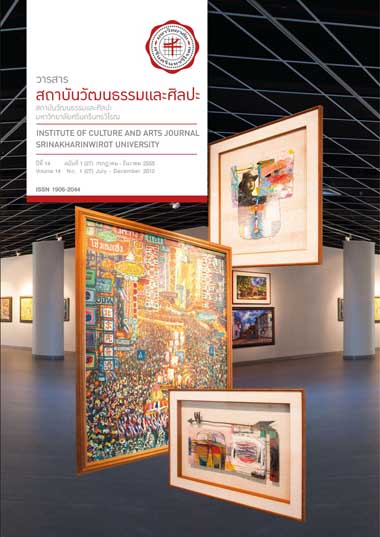การศึกษาจิตรกรรมฝาผนังในพระอุโบสถวัดนาคปรก เขตภาษีเจริญกรุงเทพมหานคร THE STUDY OF MURAL PAINTING IN WAT NAKPROK KHET PHASI CHARONE BANGKOK
บทคัดย่อ
บทคัดย่อ
การศึกษาในครั้งนี้ มีวัตถุประสงค์เพื่อศึกษาผลงานจิตรกรรมฝาผนังภายในพระอุโบสถ วัดนาคปรกทั้งหมด ในประเด็นรูปแบบสัญลักษณ์ องค์ประกอบ การจัดวาง โครงสร้างของสี และความหมายอันสัมพันธ์กับบริบททางด้านศิลปะและวัฒนธรรมของชุมชนโดยรอบที่ตั้งของวัด ซึ่งสามารถสรุปผลจากการศึกษาวิเคราะห์จิตรกรรมฝาผนัง ภาพเครื่องตั้งเครื่องโต๊ะได้ดังนี้ รูปแบบสัญลักษณ์ มีการใช้รูปแบบสัญลักษณ์ร่วมหรือเหมือนกันระหว่างวัดนาคปรกและวัดราชโอรสารามราชวรวิหาร สามารถแบ่งยุคสมัยของภาพเครื่องตั้งเครื่องโต๊ะของวัดนาคปรกและวัดราชโอรสารามราชวรวิหาร โดยใช้ฐานทางสังคมเป็นตัวกำหนด ได้เป็น “ยุคพระราชนิยม” องค์ประกอบและการจัดวาง ภาพจิตรกรรมที่อยู่บนช่องหน้าต่างได้จัดวางแบบสมดุลย์ซ้ายขวา เป็นภาพสิ่งของและสัญลักษณ์มงคล มีการใช้หลักทัศนียภาพ เพื่อแสดงให้เห็นความลึกของภาพ โดยการใช้สี จังหวะการจัดองค์ประกอบมีการเว้นช่องวางที่เหมาะสม การวาดภาพยังไม่ละเอียดนัก ใช้เส้นหน้าในการวาด ส่วนภาพจิตรกรรมที่อยู่บนฝาผนังทั้ง 4 ด้าน แบ่งการวาดเป็นช่องสี่เหลี่ยมเรียงซ้อนกันอย่างเป็นระเบียบ รวมทั้งหมด 120 ช่อง โครงสร้างของสี พื้นหลังที่ปรากฏเป็นสีขาว สีที่ใช้เป็นสีหลัก มีเพียงสีดำ สีแดง และสีเขียว ส่วนสีอื่นๆ เกิดจากการนำสีดำ สีแดง และสีเขียวมาผสมกัน ใช้สีดำในการตัดเส้น ระบายสีแบน ไม่มีการไล่สีอ่อนแก่ ไม่ปรากฏแสงเงาบนภาพ จากการศึกษาภาพจิตรกรรมเครื่องตั้งเครื่องโต๊ะ ภายในพระอุโบสถวัดนาคปรก ไม่สามารถค้นพบปริศนาธรรมจากสัญลักษณ์บนเครื่องบูชาได้ เรื่องเครื่องตั้งเครื่องโต๊ะทั้งหมด ได้ชี้จุดไปในเรื่องของความสุขเฉพาะหน้า คือ อายุยืนยาว มีโชคลาภ มีวาสนา มิได้พูดถึงเรื่องการนิพพาน การเสียสละ ทาน บารมี หรือการช่วยเหลือคนแต่อย่างใด
คำสำคัญ: จิตรกรรมเครื่องตั้งเครื่องโต๊ะ
Abstract
The purpose of this research is to fulfill the knowledge on the mural painting in Wat Nakprok Khet Phasi Charoen Bangkok. Compared were aspects of style and sign, the composition, the placing, the structure of color and the meaning related to the context of art and the culture of the community around the site of temple. The results of study and analysis of the Chinese ritual altar mural paintings are as follows: The aspects of style and sign: Applying the style and sign between Wat Nakprok and Wat Rachaorasaramrachawarawiharn. It could divide the periods of the Chinese ritual altar mural paintings and using the social base as a determination such as: “The period of royal pleasure”. Composition and placement of painting on the windows, collocated by balancing the left side and right side is the visual object and felicitous symbol. The paintings show the artists’ technique that focusing the perspective vision by color gradient, compositing by appropriate spacing, drawing roughly and using foreground drawing. The paintings on all four walls are divided to 120 rectangles. The structure of using color; white in background and mainly using only black, red and green. For other colors, they are appeared by mixing these three main colors. In addition, the artists use the black color for bolding the drawing line. They also paint with only one tone; having no color gradient and do not show the shadow in their painting. By studying the paintings of the sets of altar table in the chapel of Wat Nakprok, it could not find the Dharma puzzle. From the symbols on all sets of altar table, it points to the sustainable happiness which is long live, fortune, ascendancy without defining to the Nirvana, sacrifice, charity, acts or amelioration at all.
Keywords: The Chinese ritual altar mural paintings
Downloads
How to Cite
ฉบับ
บท
License
บทความทุกบทความที่ได้รับการตีพิมพ์ถือเป็นลิขสิทธิ์ของวารสารสถาบันวัฒนธรรมและศิลปะ มหาวิทยาลัยศรีนครินทรวิโรฒ


